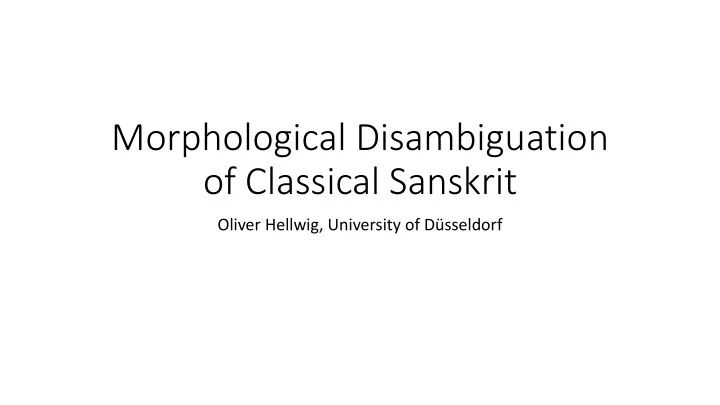

Morphological Disambiguation of Classical Sanskrit Oliver Hellwig, University of Düsseldorf
Structure • Linguistic background, corpus • System and algorithm • Improving the morphological analysis • Outlook and summary
Historical settings Vedic Sanskrit (1500?-500? BCE) Vedas, Brahmanas, early Upanishads Panini (350 BCE? North-West India) Classical Sanskrit (after Panini)
Is Sanskrit relevant and interesting? • Biggest (?) corpus of premodern texts • Reflects „elitist“ Brahmanical wordview • Broad range of topics: Religion, philosophy, science (medicine, mathematics, …), poetry, epic and narrative literature
Linguistic peculiarities of Sanskrit • Noun morphology: • 3 genders, 3 numbers, 8 cases: aśva ("horse", a masc.): aśv - aḥ (nom. sg.), aśv - am (acc. sg.), ... aśv - ābhyām (ins./abl. du.), ... aśv - eṣu (loc. pl.) ... • Different inflection classes: aśv - a (a masc.), sīt - ā (ā fem., "name of a woman"), uṣṇih (cons. fem., "a meter"), ... • Verb morphology: • Present stem (ten different classes), future, perfect, aorist; finite verbal forms (incl. absolutive) • gam ("to go", 1. present class): gacch- āmi (1. sg. pres.), gam - iṣyāmi (1. sg. fut.), a-gam- am (1. sg. thematic aor.), gatvā (absolutive), gata (past participle), ...
Problems … • Sandhi: Combination of adjacent phonetic units • aśvasy a + a yanam ("walking of the horse") [rule: a + a = ā ] => aśvasy ā yanam • aśvasy a + ā hāraḥ ("food of the horse") [rule: a + ā = ā ] => aśvasy ā hāraḥ (could also be: aśvasy a + a hāraḥ , "the non-catcher of the horse“, overgeneration of the analyzer!) • Compounding • dvandva (enumeration ): hastyaśvoṣṭr - āḥ (<= hasti ("elephant") + aśva + uṣṭr - āḥ ("camels"), "elephant(s), horse(s) and camel(s )") • tatpurusha (relation): rājaputr - aḥ (<= rāja ("king") + putra ("son"), "son of the king"); gender = gender of putra (masc.) • bahuvrihi (possession): rājaputr - ā strī ("a woman who has a son who is a king"); gender = gender of strī (fem.)
More problems … • Word order • Size of the lexicon • Orthography and ungrammaticality • Western style: yas tv ekāgre cetasi sadbhūtam arthaṃ pradyotayati … • Traditional style: yastvekāgrecetasisadbhūtam arthaṃpradyotayati • Any intermediate level: yas tvekāgre cetasi sadbhūtamarthaṃ pradyotayati
System • Lexical database with ~ 150.000 lemmata and connections into a semantic inventory • Corpus: ~ 4.000.000 gold annotated items (lexical and morphological level) • Linguistic models and information: Sandhi rule base, language models (<- corpus), prebuilt verbal forms • Tag set • Linguistic processor
Tokenization • Split sentence into words • Try to tokenize words using Sandhi rules: • Source string: āgam • No affix: āgam => 1./2./3. sg., root aorist of ā -gam ("to arrive") • āga+m : No solutions • āc [after Sandhi]+ am => [compound form of a gramm. term, āc ] + [a Mantra, aṃ ] • ā+gam => "to [ā] the goer [g -am ]“ • ā+agam => "to [ā] the tree [ag -am ]“ • a+agam => “*the non - tree“ • a+āgam => (bahuvrihi) “*( a person,) who has no singing“ • Viterbi decoding for finding the best path through the graph of hypotheses
Tokenization: Evaluation
Morphological analysis: Challenges • Second step: Choose the most probable morphological analysis for the items in the best lexical path. • Relevant for approximately 42% of all tokens aśvasy a + a yanam ("walking of the horse") aśvasya (gen. sg.) ayanam (nom. sg. neutr.) ayanam (acc. sg. neutr.) ayanam (voc. sg. neutr.) Select the most probable solution!
Morphological analysis: Models • Original implementation (tri): Viterbi decoding with trigrams of morphological tags. Ignores lexical information! • Requirements for a better decoding algorithm: • Handles categorical data (lexical and morphological information) • Sequential? • Tested: • Conditional Random Fields (sequential) • Maximum Entropy (non-sequential)
Morphological analysis: Features • Lexical and morphological information about the target word and all words with a maximal distance of 3 from the target word aśvasya (gen. sg. masc) ayanam (nom. sg. neutr.) Features for ayana-: 1. Lexical: ayanam (acc. sg. neutr.) L -2 =…, ayanam (voc. sg. neutr.) L -1 = aśva, L 0 =ayana, L +1 =… 2. Morphological: M -2 =…, M -1 =gen.sg.m., M 0 =(nom.sg.n.|acc.sg.n.|voc.sg.n.), M +1 =…
Morphological analysis: Training • Pre-filtering: Sentences with more than 2 and less than 20 lexical gold items: S 1 . • Use only those sentences from S 1 for which the lexical silver analysis is identical with the lexical gold analysis: S 2 • Training set: 95% of S 2 , test set: 5%. No CV. • Only keep lexical and morphological features that occur with a minimal frequency in the training data.
Morphological analysis: Results (I)
Morphological analysis: Results (II)
Perspectives (I) • Frame semantic labeling, „Education_teaching“; F scores CRF; lex., CRF; lex., Elman; neural Bidir. LSTM; neural morph. morph., embeddings, embeddings, word sem. morph. morph. Student 3.51 5.26 13.58 47.24 Subject 20.44 45.12 43.90 70.69 LU 28.78 43.87 78.07 92.06 Teacher 8.33 16 15.15 40.0 Increasing „neurality“!
Perspectives (II) • Task: Joint Sandhi resolution and compound splitting using only phonetic information. No external lexical and morphological resources. • aśvasyāyanam => aśvasya+ayanam. Features: a, ś, v, a, s, y, … • Bidirectional LSTM with 1-hot-encoding of phonemes as input and softmax output • Accuracy: 93.2% (vs. 94.4% of the presented system)!
Recommend
More recommend